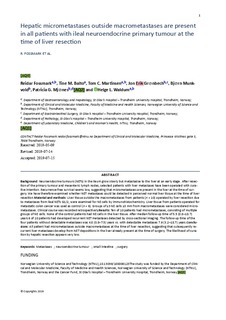| dc.contributor.author | Fossmark, Reidar | |
| dc.contributor.author | Balto, Tine Marie | |
| dc.contributor.author | Martinsen, Tom Christian | |
| dc.contributor.author | Grønbech, Jon Erik | |
| dc.contributor.author | Munkvold, Bjørn | |
| dc.contributor.author | Mjønes, Patricia | |
| dc.contributor.author | Waldum, Helge | |
| dc.date.accessioned | 2020-02-04T14:39:53Z | |
| dc.date.available | 2020-02-04T14:39:53Z | |
| dc.date.created | 2019-09-24T18:39:12Z | |
| dc.date.issued | 2019 | |
| dc.identifier.citation | Scandinavian Journal of Gastroenterology. 2019, 54 (8), 1003-1007. | nb_NO |
| dc.identifier.issn | 0036-5521 | |
| dc.identifier.uri | http://hdl.handle.net/11250/2639642 | |
| dc.description.abstract | Background: Neuroendocrine tumours (NETs) in the ileum grow slowly but metastasise to the liver at an early stage. After resection of the primary tumour and mesenteric lymph nodes, selected patients with liver metastases have been operated with curative intention. Recurrence-free survival seems low, suggesting that micrometastases are present in the liver at the time of surgery. We have therefore examined whether NET metastases could be detected in perceived normal liver tissue at the time of liver resection.
Material and methods: Liver tissue outside the macrometastases from patients (n = 10) operated by liver resection due to metastases from ileal NETs G1/2, were examined for NE cells by immunohistochemistry. Liver tissue from patients operated for metastatic colon cancer was used as control (n = 6). Groups of ≥3 NE cells ≥3 mm from macrometastases were considered micrometastases. Clinical course was recorded retrospectively.
Results: Ten of 10 patients had micrometastases, consisting of multiple groups of NE cells. None of the control patients had NE cells in the liver tissue. After median follow-up time of 5.5 (0.8–18.7) years 6 of 10 patients had developed recurrent NET metastases detected by cross-sectional imaging. The follow-up time of the four patients without detectable metastases was 4.8 (0.8–7.5) years vs. with detectable metastases 7.9 (3.2–18.7) years.
Conclusions: All patient had micrometastases outside macrometastases at the time of liver resection, suggesting that subsequently recurrent liver metastases develop from NET depositions in the liver already present at the time of surgery. The likelihood of curation by hepatic resection appears very low. | nb_NO |
| dc.language.iso | eng | nb_NO |
| dc.publisher | Taylor & Francis | nb_NO |
| dc.title | Hepatic micrometastases outside macrometastases are present in all patients with ileal neuroendocrine primary tumour at the time of liver resection. | nb_NO |
| dc.type | Journal article | nb_NO |
| dc.type | Peer reviewed | nb_NO |
| dc.description.version | acceptedVersion | nb_NO |
| dc.source.pagenumber | 1003-1007 | nb_NO |
| dc.source.volume | 54 | nb_NO |
| dc.source.journal | Scandinavian Journal of Gastroenterology | nb_NO |
| dc.source.issue | 8 | nb_NO |
| dc.identifier.doi | 10.1080/00365521.2019.1647281 | |
| dc.identifier.cristin | 1728557 | |
| dc.description.localcode | Locked until DATO due to copyright restrictions. This is an [Accepted Manuscript] of an article published by Taylor & Francis, available at https://doi.org/10.1080/00365521.2019.1647281 | nb_NO |
| cristin.unitcode | 1920,15,0,0 | |
| cristin.unitcode | 194,65,15,0 | |
| cristin.unitcode | 1920,2,0,0 | |
| cristin.unitcode | 1920,14,0,0 | |
| cristin.unitname | Medisinsk klinikk | |
| cristin.unitname | Institutt for klinisk og molekylær medisin | |
| cristin.unitname | Kirurgisk klinikk | |
| cristin.unitname | Laboratoriemedisinsk klinikk | |
| cristin.ispublished | true | |
| cristin.fulltext | postprint | |
| cristin.qualitycode | 1 | |
